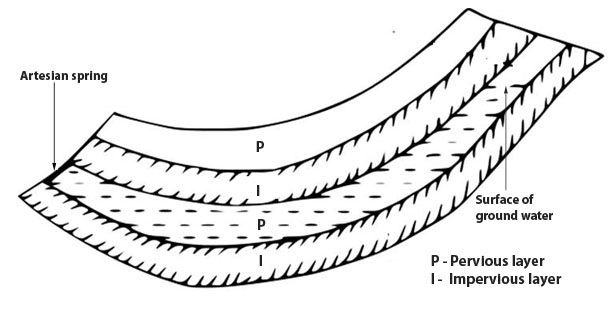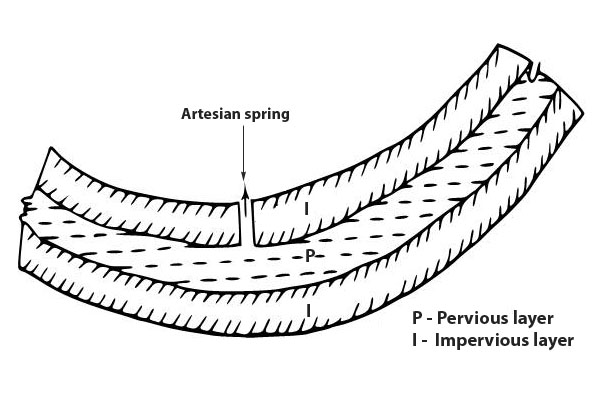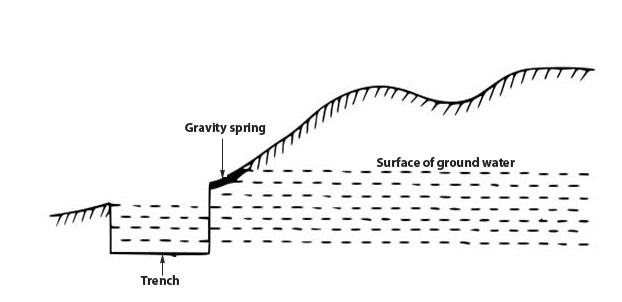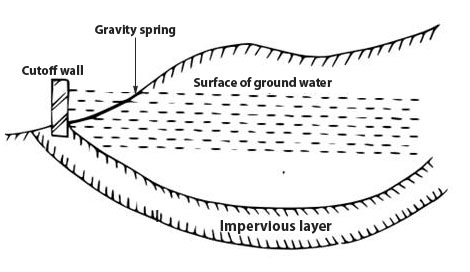Site pages
Current course
Participants
General
Module 1. IMPORTANCE OF SAFE WATER SUPPLY SYSTEM
Module 2. DOMESTIC WATER REQUIREMENTS FOR URBAN AN...
Module 3. DRINKING WATER QUALITY AND INDIAN STANDA...
Module 4. INTRODUCTION TO WATER TREATMENT, DOMESTI...
Module 5. SEWER: TYPES, DESIGN DISCHARGE AND HYDRA...
Module 6. INTRODUCTION TO DOMESTIC WASTEWATER TREA...
Module 7. SOLID WASTE: QUANTITY, CHARACTERISTICS A...
Module 8. INTRODUCTION TO AIR POLLUTION. TYPES OF ...
Module 9. ISI STANDARDS FOR POLLUTANTS IN AIR AND ...
26 April - 2 May
Lesson-4 Sources of water supply
Sources from which water is available for water supply schemes can conveniently be classified into the following two categories according to their proximity to the ground surface, viz., surface and underground source
Surface waters
In this type of source, the surface runoff is available for water supply schemes. Usual forms of surface sources are as follows:
- Lakes and streams
- Ponds
- Rivers
- Storage reservoirs
Lakes and streams
A natural lake represents a large body of water within land with impervious bed. Hence, it may be used as source of water supply scheme for nearby localities. The quantity of runoff that goes to the lake should be accurately determined and it should be seen that it is at least equal to the expected demand of locality. Similar is the case with streams which are formed by the surface runoff. It is found that the flow of water in streams is quite ample in rainy season. But it becomes less and less in hot season and sometimes the stream may even become absolutely dry.
The catchment area of lakes and streams is very small and hence, the quantity of water available from them is also very low. Hence, lakes and streams are not considered as principal sources of water supply schemes for the large cities. But they can be adopted as sources of water supply schemes for hilly areas and small towns.
The water which is available from lakes and streams is generally free from undesirable impurities and can therefore be safely used for drinking purposes.
Ponds
A pond is a man-made body of standing water smaller than a lake. Thus ponds are formed due to excessive digging of ground for the construction of roads, houses, etc and they are filled up with water in rainy season. The quantity of water in pond is very small and it contains many impurities.
A pond cannot be adopted as a source of water supply and its water can only be used for washing of clothes or animals only.
Rivers
Since the dawn of civilization, the ancient man settled on the banks of river, drank river water and ate fish caught from river water and sailed down rivers to find out unknown lands.
Large rivers constitute the principal source of water supply schemes for many cities. Some rivers are perennial while others are non-perennial. The former rivers are snowfed and hence, water flows in such rivers for all the seasons. The latter type of rivers dries in summer either wholly or partly and in monsoon, heavy flood visits them. For such types of rivers, it is desirable to store the excess water of flood in monsoons by constructing dams across such rivers. This stored water may then be used in summer.
In order to ascertain the quantity of water available from the river, the discharges at various periods of the year are taken and recorded. The observations over a number of years serve as a good guide for estimating the quantity of water available from the river in any particular period of the year.
Generally, the quantity of water available from non-perennial rivers is variable throughout the year and it is likely to fall down in hot season when demand of water is maximum. It becomes therefore essential to augment such source of water supply by some other sources so as to make the water supply scheme successful.
The quality of surface water obtained from rivers is not reliable. It contains silt and suspended impurities. When completely or partly treated sewage is being discharged into the river at some upstream point, the river water is to be suspected for high contamination. The river water requires to be properly analyzed as regards to the contents of disease bacteria, harmful impurities, etc. The presence of all such undesirable elements in river water requires an exhaustive treatment of water before it can be make fit for drinking purposes. It should however be noted that the quality of river water is subject to the widest variations because it depends on various uncertain factors such as character of the catchment area, the discharges of sewage and industrial wastes, climatic conditions, season of the year, etc. The character of the water differs not only with each individual river, but also at many points along the course of the same river. It is usually found that the quality of river water at its head is good, but it goes on deteriorating as the river proceeds along its course.
The chief use points to be considered in investigating a river supply of water are as follows:
-
Adequacy of storage of purified water so as not to disturb the distribution system during periods of fold when the river water is turbid
-
Efficiency of the subsequent stages of purification system adopted
-
General nature of river, the rate of flow and the distance between the sources of pollution and the intake of the water and
-
Relative proportions of the polluting matter and the flow of river when at its minimum.
Storage reservoirs
An artificial lake formed by the construction of dam across a valley is termed as a storage reservoir. It essentially consists of the following three parts
-
A dam to hold water
-
A spillway to allow the excess water to flow and
-
A gate chamber containing necessary valves for regulating the flow of water
At present, this is rather the chief source of water supply schemes for very big cities. The multi purpose reservoirs also make provisions for other uses in addition to water supply such as irrigation and power generation.
Underground sources
In this type of source, the water that has percolated into the ground is brought on the surface. The difference between the terms infiltration and percolation should be noted. The entrance of rain water or melted snow into the ground is referred to as infiltration. The movement of water after entrance is called percolation
It is observed that the surface of earth consists of alternate courses of pervious and impervious strata. The pervious layers are those through which water can easily pass while it is not possible for water to go through an impervious layer.
The pervious layers are known as aquifers or water-bearing strata. If aquifer consists of sand and gravel strata, it gives good supply of drinking water. The aquifer of limestone strata can supply good amount of drinking water, provided there is presence of cracks or fissures in it.
Forms of underground sources
Following are the four forms in which underground sources are found
-
Infiltration galleries
-
Infiltration wells
-
Springs
-
Wells
Each of the above form will now be separately discussed in brief
Infiltration galleries
An infiltration gallery is a horizontal or nearly horizontal tunnel which is constructed through water bearing strata. It is sometimes referred to as horizontal well
The gallery is usually constructed of brick walls with slab roof as shown in the figure. The gallery obtains its water from water bearing strata by various porous drain pipes. These pipes are covered with gravel, pebble, etc. so as to prevent the entry of very fine material into the pipe.
The gallery is laid at a slope and the water collected in the gallery is led to a sump from where it is pumped and supplied to consumers after proper treatment. The manholes are provided along the infiltration gallery for the purposes of cleaning and inspection.
 The infiltration galleries are useful as sources of water supply when ground water is available in sufficient quantity just below ground level or so. The galleries are usually constructed at depth of about 5 to 10 metres from the ground level.
The infiltration galleries are useful as sources of water supply when ground water is available in sufficient quantity just below ground level or so. The galleries are usually constructed at depth of about 5 to 10 metres from the ground level.
The infiltration galleries are useful as sources of water supply when ground water is available in sufficient quantity just below ground level or so. The galleries are usually constructed at depth of about 5 to 10 metres from the ground level.
Infiltration wells
In order to collect large quantities of water, infiltration wells are sunk in series in the banks of river. The wells are closed at top and open at bottom. They are constructed of brick masonry with open joints as shown in figure

For the purpose of inspection of well, manholes are provided in the top cover. The water infiltrates through the bottom of such wells and as it has to pass through a sand bed, it gets purified to some extent.
The infiltration wells in turn are connected by porous pipes to a collecting sump, known as jack well as shown in figure and the water thus collected through the infiltration wells then flows by gravity into the jack well. The water from jack well is pumped to purification plant for treatment.
Springs
When ground water appears at the surface for any reason, springs are formed. They serve as source of water supply for small towns, especially near hills or bases of hills. Some springs discharge hot water due to presence of sulphur and other minerals in their formations. These
A good spring proves to be a sure source of water. But it is difficult to find a good spring for the purpose of water supply scheme. However, when a spring is to be developed as a source of water supply, the following factors should be carefully ascertained:
-
It should be easier, cheaper and surer enough to develop the spring for the locality than to adopt any other source of water supply.
-
The flow of water should be adequate, even in dry weather
-
The spring should be adequately protected from the water pollution sources
-
The spring should be so located as to have natural gravity flow
-
The water should be of good quality
Following are the three types of springs
-
Artesian springs
-
Gravity springs
-
Surface springs
Artesian springs
In this type of spring, the ground water comes to the surface under pressure as shown in the figure

The artesian spring may also be formed due to presence of fissure or crack in impervious layer as shown in the figure. The fissure or crack should be continued upto the ground surface. The artesian springs give practically uniform quantity of water throughout the year.

Gravity springs
This type of spring develops due to overflowing of the water table as shown in the figure. The flow from a gravity spring is variable with the rise or fall of water table. In order to meet with such fluctuations, a trench may be constructed near such a spring as shown in the figure. The trench acts as a storage reservoir.

Surface springs
This type of spring is formed when subsoil water is exposed to the ground surface by the obstruction of an impervious layer as shown in the figure.

The quantity of water available from surface springs is quite uncertain and cut-off walls, as shown in the figure, may be constructed to develop such springs.
It is found that the quality of spring water depends on geological and topographical conditions and it may be hard or soft, pure or polluted or sometimes saline, etc. Similarly, the yield from springs is mostly inadequate, except for small supplies. The spring water which is not disturbed by rainfall is usually attractive in appearance and of good palatability.
Wells
A well is defined as an artificial hole or pit made in the ground for the purpose of tapping water. The holes made for tapping oil are also known as wells. But in the general sense, a well indicates a source of water. In
The three factors which form the basis of theory of wells are as follows:
-
Geological conditions of earth’s surface,
-
Porosity of various layers and
-
Quantity of water which is absorbed and stored in different layers.
The geological conditions of earth’s surface indicate the slope of water bearing strata. If the slope of water bearing layers is towards the well, there will be some quantity of water in the well even during the severe hot season. On the other hand, if the slope of water bearing layers is away from the well, such well will soon get dry and it will only give some quantity of water only in monsoon.
The porosity of aquifers will also play a great role in determining the quantity of water in the well. If the porosity of aquifers is more, the well will easily collect more quantity of water in less time. The capacity of aquifers to absorb and store water will determine the supply rate of water to the well. If the aquifers are capable of storing more water, the well will get more quantity of water and practically at a constant rate.